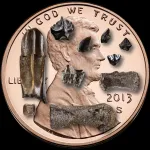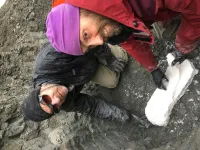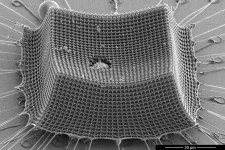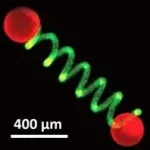(Press-News.org) In the 1950s, researchers made the first unexpected discoveries of dinosaur remains at frigid polar latitudes. Now, researchers reporting in the journal Current Biology on June 24 have uncovered the first convincing evidence that several species of dinosaur not only lived in what's now Northern Alaska, but they also nested there.
"These represent the northernmost dinosaurs known to have existed," says Patrick Druckenmiller of the University of Alaska Museum of the North. "We didn't just demonstrate the presence of perinatal remains--in the egg or just hatched--of one or two species, rather we documented at least seven species of dinosaurs reproducing in the Arctic."
Previous studies at a handful of other sites provided tantalizing bits of evidence that one or two species of indeterminate dinosaurs were capable of nesting near or just above the Arctic or Antarctic circles, he says, but this study is the first to show unequivocal evidence of nesting at extremely high latitudes. Environmental conditions at this time and place indicate challenging seasonal extremes, with an average annual temperature of about 6 degrees Celsius (about 40 degrees Fahrenheit). There also would have been about four months of full winter darkness with freezing conditions.
Druckenmiller and co-author Gregory Erickson from Florida State University have a longstanding project to document the ancient Arctic ecosystem of the Prince Creek Formation in Northern Alaska, including its dinosaurs, mammals, and other vertebrates. They also want to know how they lived there, given the challenging environment. The environment is also a difficult place to work.
"The field season is short in the Arctic and access is very difficult--aircraft and small boats are required," Druckenmiller says. "To make matters more challenging, the only way to see the rocks is in river-cut steep bluffs along the largest river in Northern Alaska, the Colville. These bluffs are dangerous, prone to catastrophic collapses, making it hard to safely find and extract fossils. As such, we have focused on finding discrete bonebed horizons where we can more efficiently excavate many bones. In the process, we've also discovered numerous new microfossil deposits that have provided for a wealth of new knowledge about the whole ecosystem that lived in the Arctic over 70 million years ago."
Over the course of about a decade of painstaking work, the researchers, aided by many students they've enlisted over the years, have now found hundreds of small baby dinosaur bones, including tiny teeth from individuals that were either still in the egg or had just hatched out. The Arctic dinosaurs they've uncovered include small- and large-bodied herbivorous species including hadrosaurids (duck-billed dinosaurs), ceratopsians (horned dinosaurs and leptoceratopsians), thescelosaurs and carnivores (tyrannosaurs, troodontids, and dromaeosaurs).
"It wasn't that long ago that the idea of finding any dinosaurs in such extreme latitudes and environments was a surprise," Druckenmiller says. "To then find out that most if not all of those species also reproduced in the Arctic is really remarkable. We have long been asked, 'Have you found any eggs?' To that we have, and still answer 'no.' But, we have something much better: the actual baby dinosaurs themselves."
The findings add to evidence that the dinosaurs didn't just spend time at these extreme latitudes, but they most likely lived there as year-round residents. Their evidence suggests both smaller dinosaurs and larger species, such as duck-billed dinosaurs, horned dinosaurs, and a tyrannosaur that more likely could have migrated to warmer climes, resided in the Arctic.
"Year-round residency in the Arctic provides a natural test of dinosaurian physiology," Erickson says. "Cold-blooded terrestrial vertebrates like amphibians, lizards, and crocodilians have yet to be found, only warm-blooded birds and mammals--and dinosaurs. I think that this is some of the most compelling evidence that dinosaurs were in fact warm-blooded."
Erickson says they now have new questions about how dinosaurs survived Arctic winters. It's likely they had unique strategies to cope with darkness, cold temperatures, and food limitation, the researchers say.
INFORMATION:
Current Biology, Druckenmiller et al.: "Nesting at Extreme Polar Latitudes by Non-Avian Dinosaurs" https://www.cell.com/current-biology/fulltext/S0960-9822(21)00739-9
Current Biology (@CurrentBiology), published by Cell Press, is a bimonthly journal that features papers across all areas of biology. Current Biology strives to foster communication across fields of biology, both by publishing important findings of general interest and through highly accessible front matter for non-specialists. Visit http://www.cell.com/current-biology. To receive Cell Press media alerts, contact press@cell.com.
Images of dinosaurs as cold-blooded creatures needing tropical temperatures could be a relic of the past.
University of Alaska Fairbanks and Florida State University scientists have found that nearly all types of Arctic dinosaurs, from small bird-like animals to giant tyrannosaurs, reproduced in the region and likely remained there year-round.
Their findings are detailed in a new paper published in the journal Current Biology.
"It wasn't long ago that people were pretty shocked to find out that dinosaurs lived up in the Arctic 70 million years ago," said Pat Druckenmiller, the paper's lead author and director of the ...
The 'anterior cingulate cortex' is key brain region involved in linking behaviours to their outcomes.
When this region was temporarily silenced, monkeys did not change behaviour even when it stopped having the expected outcome.
The finding is a step towards targeted treatment of human disorders involving compulsive behaviour, such as OCD and eating disorders, thought to involve impaired function in this brain region.
Researchers have discovered a specific brain region underlying 'goal-directed behaviour' - that is, when we consciously do something with a particular goal in mind, for example going to the shops to buy food.
The ...
LA JOLLA, CA--New research led by scientists at La Jolla Institute for Immunology (LJI) and the University of Liverpool may explain why many cancer patients do not respond to anti-PD-1 cancer immunotherapies--also called checkpoint inhibitors.
The team reports that these patients may have tumors with high numbers of T follicular regulatory (Tfr) cells.
In a healthy person, Tfr cells do the important job of stopping haywire T cells and autoantibodies from attacking the body's own tissues. But in a cancer patient, Tfr cells dramatically dial back the body's ability to kill cancer cells.
Anti-PD-1 cancer immunotherapies boost the body's cancer-fighting T cells, but ...
'Precision agriculture' where farmers respond in real time to changes in crop growth using nanotechnology and artificial intelligence (AI) could offer a practical solution to the challenges threatening global food security, a new study reveals.
Climate change, increasing populations, competing demands on land for production of biofuels and declining soil quality mean it is becoming increasingly difficult to feed the world's populations.
The United Nations (UN) estimates that 840 million people will be affected by hunger by 2030, but researchers have developed a roadmap combining smart and nano-enabled agriculture with AI and machine learning capabilities that could help to reduce this ...
A new study by engineers at MIT, Caltech, and ETH Zürich shows that "nanoarchitected" materials -- materials designed from precisely patterned nanoscale structures -- may be a promising route to lightweight armor, protective coatings, blast shields, and other impact-resistant materials.
The researchers have fabricated an ultralight material made from nanometer-scale carbon struts that give the material toughness and mechanical robustness. The team tested the material's resilience by shooting it with microparticles at supersonic speeds, and found that the material, which is thinner than the width of a human hair, prevented the miniature projectiles from tearing through ...
HAMILTON, ON June 24, 2021 -- The idea of visiting the doctor's office with symptoms of an illness and leaving with a scientifically confirmed diagnosis is much closer to reality because of new technology developed by researchers at McMaster University.
Engineering, biochemistry and medical researchers from across campus have combined their skills to create a hand-held rapid test for bacterial infections that can produce accurate, reliable results in less than an hour, eliminating the need to send samples to a lab.
Their proof-of-concept research, published today in the journal Nature Chemistry, specifically describes the test's ...
In a few years, a new generation of quantum simulators could provide insights that would not be possible using simulations on conventional supercomputers. Quantum simulators are capable of processing a great amount of information since they quantum mechanically superimpose an enormously large number of bit states. For this reason, however, it also proves difficult to read this information out of the quantum simulator. In order to be able to reconstruct the quantum state, a very large number of individual measurements are necessary. The method used to read out the quantum state of a ...
A University of Bristol-led team of international scientists with an interest in protoliving technologies, has today published research which paves the way to building new semi-autonomous devices with potential applications in miniaturized soft robotics, microscale sensing and bioengineering.
Micro-actuators are devices that can convert signals and energy into mechanically driven movement in small-scale structures and are important in a wide range of advanced microscale technologies.
Normally, micro-actuators rely on external changes in bulk properties such as pH and temperature to trigger repeatable mechanical ...
What The Study Did: Researchers found no association between recent vaccination with the Pfizer-BioNTech BNT162b2 COVID-19 vaccine and risk of facial nerve palsy.
Authors: Asaf Shemer, M.D., of the Shamir Medical Center in Be'er Ya'akov, Israel, is the corresponding author.
To access the embargoed study: Visit our For The Media website at this link https://media.jamanetwork.com/
(doi:10.1001/jamaoto.2021.1259)
Editor's Note: Please see the article for additional information, including other authors, author contributions and affiliations, conflict of interest and financial disclosures, and funding and support.
INFORMATION:
Media ...
What The Study Did: Researchers estimated the change in life expectancy associated with the COVID-19 pandemic in the United States by race/ethnicity.
Authors: Theresa Andrasfay, Ph.D., of the University of Southern California, Los Angeles, is the corresponding author.
To access the embargoed study: Visit our For The Media website at this link https://media.jamanetwork.com/
(doi:10.1001/jamanetworkopen.2021.14520)
Editor's Note: The article includes funding/support disclosures. Please see the article for additional information, including other authors, author contributions and affiliations, conflict of interest and financial disclosures, and funding and support.
INFORMATION:
Media advisory: The full study is linked to this news release.
Embed ...






